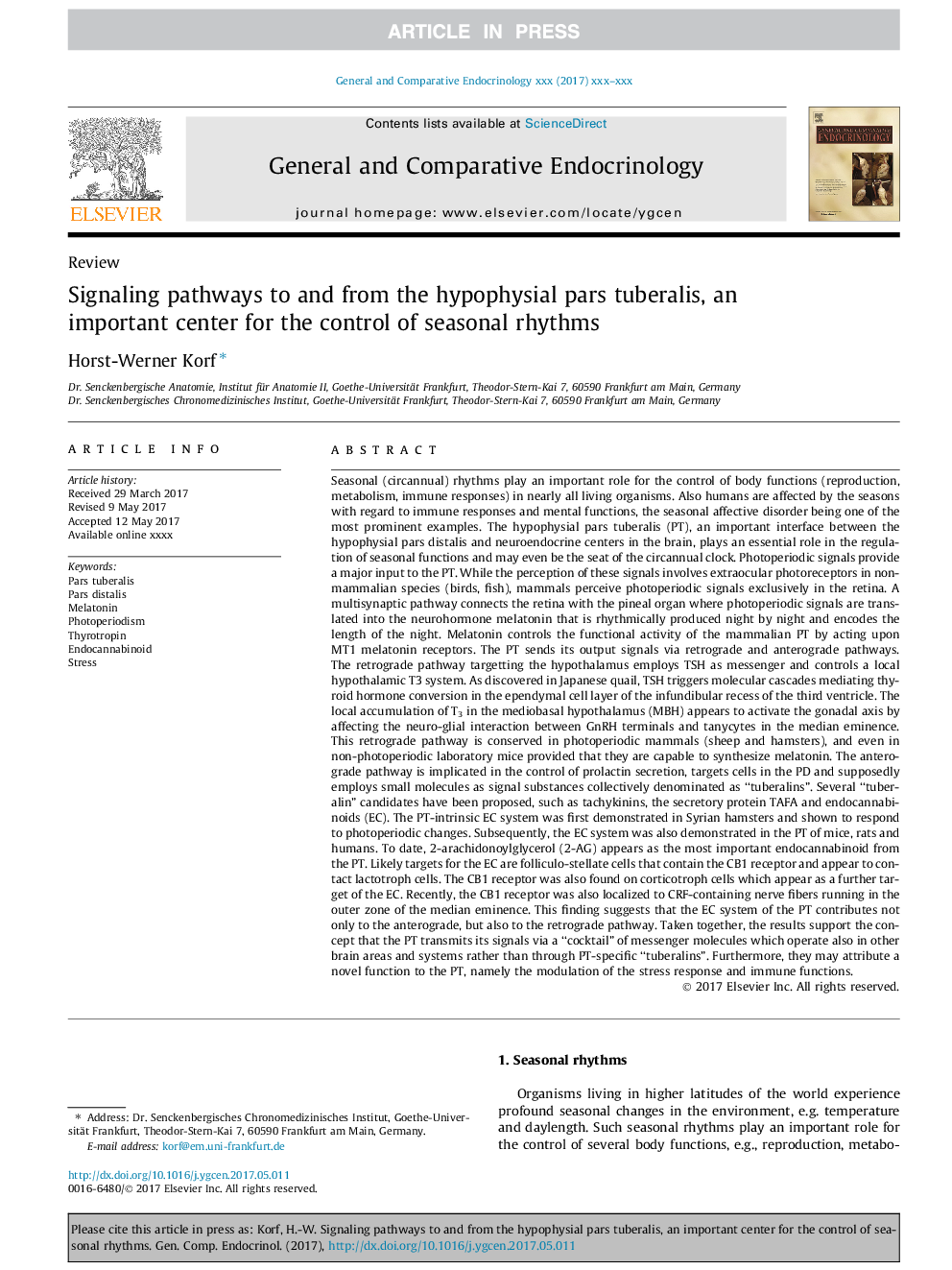| کد مقاله | کد نشریه | سال انتشار | مقاله انگلیسی | نسخه تمام متن |
|---|---|---|---|---|
| 8631287 | 1568849 | 2018 | 8 صفحه PDF | دانلود رایگان |
عنوان انگلیسی مقاله ISI
Signaling pathways to and from the hypophysial pars tuberalis, an important center for the control of seasonal rhythms
ترجمه فارسی عنوان
مسیرهای سیگنالینگ به و از پارس تیپریالیز هیپوفیزیک، مرکز مهمی برای کنترل ریتم های فصلی
دانلود مقاله + سفارش ترجمه
دانلود مقاله ISI انگلیسی
رایگان برای ایرانیان
کلمات کلیدی
موضوعات مرتبط
علوم زیستی و بیوفناوری
بیوشیمی، ژنتیک و زیست شناسی مولکولی
علوم غدد
چکیده انگلیسی
Seasonal (circannual) rhythms play an important role for the control of body functions (reproduction, metabolism, immune responses) in nearly all living organisms. Also humans are affected by the seasons with regard to immune responses and mental functions, the seasonal affective disorder being one of the most prominent examples. The hypophysial pars tuberalis (PT), an important interface between the hypophysial pars distalis and neuroendocrine centers in the brain, plays an essential role in the regulation of seasonal functions and may even be the seat of the circannual clock. Photoperiodic signals provide a major input to the PT. While the perception of these signals involves extraocular photoreceptors in non-mammalian species (birds, fish), mammals perceive photoperiodic signals exclusively in the retina. A multisynaptic pathway connects the retina with the pineal organ where photoperiodic signals are translated into the neurohormone melatonin that is rhythmically produced night by night and encodes the length of the night. Melatonin controls the functional activity of the mammalian PT by acting upon MT1 melatonin receptors. The PT sends its output signals via retrograde and anterograde pathways. The retrograde pathway targetting the hypothalamus employs TSH as messenger and controls a local hypothalamic T3 system. As discovered in Japanese quail, TSH triggers molecular cascades mediating thyroid hormone conversion in the ependymal cell layer of the infundibular recess of the third ventricle. The local accumulation of T3 in the mediobasal hypothalamus (MBH) appears to activate the gonadal axis by affecting the neuro-glial interaction between GnRH terminals and tanycytes in the median eminence. This retrograde pathway is conserved in photoperiodic mammals (sheep and hamsters), and even in non-photoperiodic laboratory mice provided that they are capable to synthesize melatonin. The anterograde pathway is implicated in the control of prolactin secretion, targets cells in the PD and supposedly employs small molecules as signal substances collectively denominated as “tuberalins”. Several “tuberalin” candidates have been proposed, such as tachykinins, the secretory protein TAFA and endocannabinoids (EC). The PT-intrinsic EC system was first demonstrated in Syrian hamsters and shown to respond to photoperiodic changes. Subsequently, the EC system was also demonstrated in the PT of mice, rats and humans. To date, 2-arachidonoylglycerol (2-AG) appears as the most important endocannabinoid from the PT. Likely targets for the EC are folliculo-stellate cells that contain the CB1 receptor and appear to contact lactotroph cells. The CB1 receptor was also found on corticotroph cells which appear as a further target of the EC. Recently, the CB1 receptor was also localized to CRF-containing nerve fibers running in the outer zone of the median eminence. This finding suggests that the EC system of the PT contributes not only to the anterograde, but also to the retrograde pathway. Taken together, the results support the concept that the PT transmits its signals via a “cocktail” of messenger molecules which operate also in other brain areas and systems rather than through PT-specific “tuberalins”. Furthermore, they may attribute a novel function to the PT, namely the modulation of the stress response and immune functions.
ناشر
Database: Elsevier - ScienceDirect (ساینس دایرکت)
Journal: General and Comparative Endocrinology - Volume 258, 1 March 2018, Pages 236-243
Journal: General and Comparative Endocrinology - Volume 258, 1 March 2018, Pages 236-243
نویسندگان
Horst-Werner Korf,
